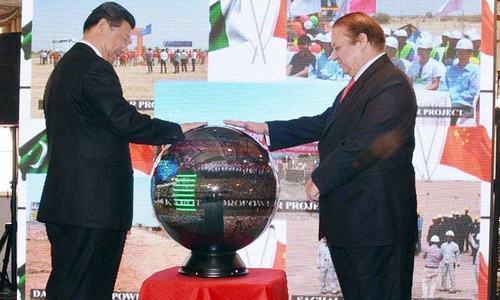
THE China-Pakistan Economic Corridor (CPEC) is apparently entering a new phase, touching more critical and sensitive areas of trade, industrialisation and financial settlement systems than did the first phase, which focused on developing power projects and road infrastructure.
The broad power policy was already in place when the two countries agreed to expand around 10,000 megawatts of generation capacity to remove energy bottlenecks.
Also related: What does the next phase of CPEC look like?
The Chinese made abundant funds available for investments and Pakistan offered generous tax concessions and exemptions along with guaranteed revenue stream for repayments.
The private sector would be playing a greater role, hence the need for financial mechanisms including the yuan as an alternative to the dollar
While the quantum of investments in the power sector and loans for road projects currently under implementation is put at $27 billion by the Planning Commission and $23bn by the Ministry of Finance for varying reasons, rough estimates suggest that these would add to foreign repayment obligations by $3bn to 3.5bn per annum over the next few years.
Going forward, the two governments have now formally shaped up the Long Term Plan (LTP) 2017-30, which sets the general direction for the next 13 years of engagement.
The private sector would be playing a greater role in bilateral trade and industrialisation, hence the need for financial mechanisms and arrangements including the treatment of the yuan — or renminbi (RMB) — as an alternative to the US dollar.
This could be the most important phase of the CPEC that would determine its sustainability and depend on the actual planning, clarity and transparency of the arrangements to avoid mid-course challenges.
Pakistan has to draw wisdom from the experience of its free trade agreement with China, and preparedness of the private sector and the human resources to benefit from the special economic zones (SEZs).
That is where the two governments have set up the joint expert group, in addition to existing sectoral joint working groups, to meet on a monthly basis and process feasibility studies and address issues that may crop up.
The main task for the expert group is to complete the planning phase of these SEZs and make sure it enters the implementation phase during 2018 that would, in the meanwhile, expected to complete the political transition in Pakistan. Therefore, the upcoming year would generally be a dull year for actual progress on ground.
The Board of Investment and the Planning Commission are engaging with prominent chambers of commerce and industry in Khyber Pakhtunkhwa, Punjab, Islamabad, Sindh, Gilgit-Baltistan (GB), Azad Jammu and Kashmir (AJK), and the Federation of Pakistan Chambers of Commerce and Industry, among others, for briefings about upcoming SEZs.
The repeated questions coming from the business community in these sessions pertained to concerns that the incentive package would be restricted to Chinese investors.
The government has tried to dispel such impressions. Local businessmen have also been told that all the nine SEZs — identified so far in all the four provinces and special areas including AJK, GB and Federally Administered Tribal Areas — would be initially developed by provincial governments for building infrastructure in various forms of public-private partnerships.
This would be followed by setting up industrial units for which the federal government would offer equal incentives to all. Provincial governments would also be free to give additional tax incentives to attract local and foreign investors.
The LTP generally covers seven broad areas of cooperation in three phases, first ending by 2020, second by 2025 and third in 2030.
The areas of cooperation include energy and connectivity (already in the completion phase except for railway lines), trade and industrial parks, financial cooperation (the next stage), agricultural development and poverty alleviation, tourism, peoples livelihood and exchange programmes.
The long-term plan would remain a moving document providing macroeconomic guidance for implementing the CPEC in the next phase. “The plan would be adjusted based on real situation as well as the consensus between the parties during the course of implementation… New routes, nodes and aspects may be considered for inclusion in future by mutual agreement,” reads the document.
The plan promises to explore the establishment of multi-level cooperation mechanisms and strengthen policy coordination, including their own financial reform and opening up besides innovating financial products and financial services to control financial risks.
This also includes the understanding to establish and improve a cross-border credit system and financial services, strengthen currency-swap arrangements and establish a bilateral payment and settlement system.
Pakistan and China have also agreed to set up a bilateral foreign exchange reserve pool, increase cooperation between central banks and financial regulatory agencies, and establish a settlement platform for yuan-based cross-border trade.
The countries would also consider expanding the amount of currency swap and assign the foreign currency to domestic banks through credit-based bids to support the financing for projects along the CPEC and promote the settlement in domestic currencies (yuan and rupees) to reduce the demand for a third-party currency.
The two countries would also promote the free flow of capital in an orderly manner, and enhance the facilitation in cross-border transfer of legitimate funds and open up their financial sector to each other.
They agreed to encourage financial institutions of the two countries to support the financing, including the loans from international consortium of banks, for the projects along the CPEC and establish and improve a cross-border credit system.
Published in Dawn, The Business and Finance Weekly, December 25th, 2017














































